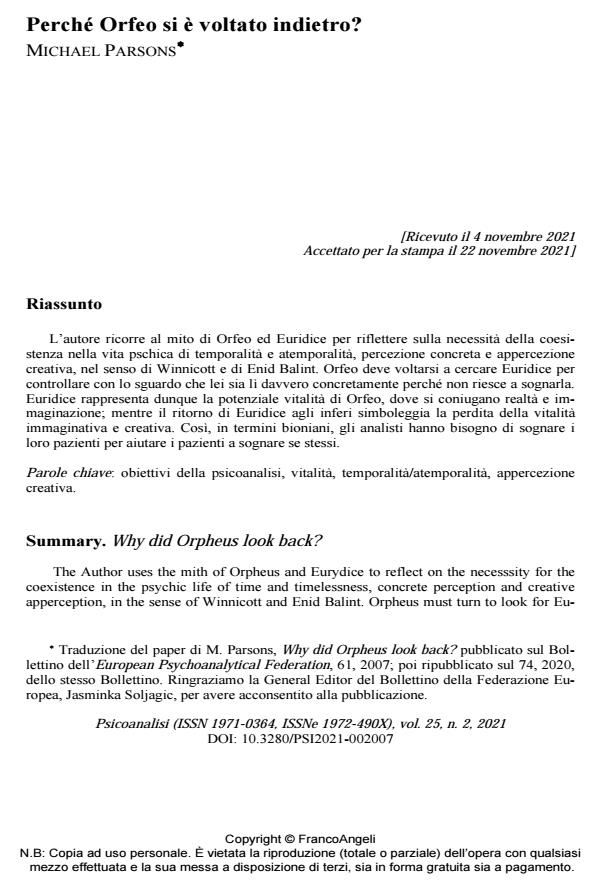Why did Orpheus look back?
Journal title PSICOANALISI
Author/s Michael Parsons
Publishing Year 2021 Issue 2021/2 Language Italian
Pages 10 P. 101-110 File size 177 KB
DOI 10.3280/PSI2021-002007
DOI is like a bar code for intellectual property: to have more infomation
click here
Below, you can see the article first page
If you want to buy this article in PDF format, you can do it, following the instructions to buy download credits

FrancoAngeli is member of Publishers International Linking Association, Inc (PILA), a not-for-profit association which run the CrossRef service enabling links to and from online scholarly content.
The Author uses the mith of Orpheus and Eurydice to reflect on the necesssity for the co-existence in the psychic life of time and timelessness, concrete perception and creative apper-ception, in the sense of Winnicott and Enid Balint. Orpheus must turn to look for Eurydice to ceck with his own eyes that she is really there, because he is not able to dream her. Eurydice, therefore, represents Orpheus’s potential vitality, where reality and imagination merge; while Eurydice’s return to the underwordl symbolises the loss of imaginative and creative vitality. So, in bionian terms, the analysts need to dream their patients to help their patients to dream themselves.
Keywords: objectives of psychoanalysis, vitality, time/timelessness, creative apperception.
- Balint E. (1993). Before I was I: Psychoanalysis and the Imagination. Collected Papers of Enid Balint. Edited by Mitchell, J., Parsons, M.. London: Free Association Books and Guilford Press.
- Bion W. (1962). Learning from Experience. London: Heinemann.
- Cooper A. (1996). “Foreword” to What do Psychoanalysts Want? The Problem of Aims in Psychoanalytical Therapy. Edited by Sandler J., Dreher U.. London: Routledge, 1996, pp. ix-xiv.
- Guntrip H. (1975). My experiences of analysis with Fairbairn and Winnicott. Int. Rev. Psychoanal. 2: 145-156.
- Ogden Th. (1995). Analysing forms of aliveness and deadness of the transference-countertransference. Int. J. Psychoanal., 76: 695-709.
- Ogden Th. (2003). On not being able to dream. Int. J. Psychoanal., 84: 17-30.
- Parsons M. (2006). The analyst’s countertransference to the psychoanalytic process. Int. J. Psychoanal., 87: 1183-1198.
- Sandler J., Dreher U. (1996). What do Psychoanalysts Want? The Problem of Aims in Psychoanalytical Therapy. London: Routledge.
- Winnicott C. (1989). D.W.W.: A Reflection. In: Psychoanalytic Explorations. London: Karnac.
- Winnicott D.W. (1965). The Maturational Processes and the Facilitating Environ-ment: Studies in the Theory of Emotional Development. London: Hogarth Press (trad. it. Sviluppo affettivo e ambiente. Roma: Armando, 1970).
- Winnicott D.W. (1971). Playing and Reality. London: Tavistock (trad. it. Gioco e realtà. Roma: Armando, 1974).
Michael Parsons, Perché Orfeo si è voltato indietro? in "PSICOANALISI" 2/2021, pp 101-110, DOI: 10.3280/PSI2021-002007